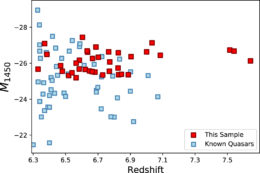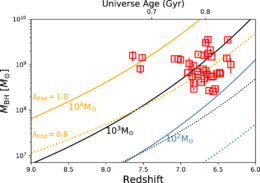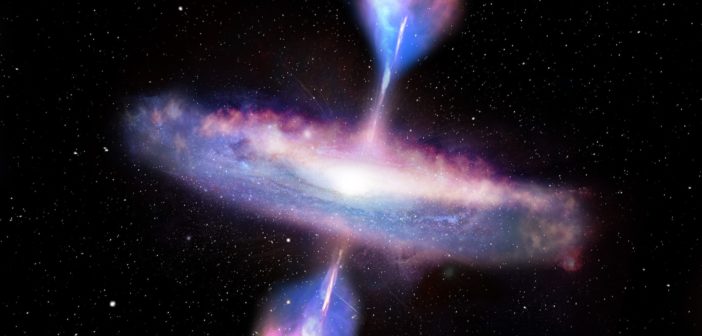Supermassive black holes power the bright nuclei of young galaxies in the early universe — quasars. But how do these black holes gain supermassive status in less than a billion years?
Supermassive Centers

Simulation of galaxies ionizing hydrogen gas (bright areas) during the epoch of reionization. [M. Alvarez (http://www.cita.utoronto.ca/~malvarez), R. Kaehler, and T. Abel/ESO]
These ultra-bright objects are thought to be the nuclei of young galaxies, powered by the accretion of material onto a central supermassive black hole. The presence of supermassive black holes so early in the universe’s history poses a challenge for theorists. How, exactly, does a black hole amass so much material in just a few hundred million years?

Redshifts and absolute magnitudes of the quasars in this study compared to other studies. Higher redshifts correspond to larger distances and farther back in time. [Yang et al. 2021]
Sensitive Spectroscopy
The size of a supermassive black hole in the early universe is determined by the masses of the smaller black hole “seeds” from which it forms as well as the rate at which it accretes gas from its surroundings. In order to determine the masses and accretion rates of young supermassive black holes, a team led by Jinyi Yang (Steward Observatory, University of Arizona) analyzed infrared spectra of 37 quasars with redshifts between 6.3 and 7.64 — roughly 700 to 900 million years after the Big Bang.
Yang and collaborators calculated the masses of the black holes in their sample to be in the range of 300 million to 3.6 billion solar masses and found that they accrete at 0.26 to 2.3 times the Eddington limit — the theorized point at which the outward push of radiation generated by accretion is so strong that it balances the inward pull of gravity.
Gauging Growth

Measured black hole masses (red squares) with black hole growth tracks for different seed masses and accretion rates. [Yang et al. 2021]
Even if the seeds are small, rapid accretion could still bulk these early-universe black holes up to the masses we observe. However, in order to reach billions of solar masses, early-universe black holes would need nearly a billion years of sustained accretion at a rate far exceeding the Eddington limit — anywhere from a few to a few thousand times this limit, depending on the seed mass — and most of the quasars in this study are accreting too slowly. The jury is still out on how supermassive black holes in the early universe gain their impressive size — perhaps in addition to being the most luminous and most interesting objects in the universe, quasars are also the most mysterious!
Citation
“Probing Early Supermassive Black Hole Growth and Quasar Evolution with Near-infrared Spectroscopy of 37 Reionization-era Quasars at 6.3 < z ≤ 7.64,” Jinyi Yang et al 2021 ApJ 923 262. doi:10.3847/1538-4357/ac2b32

